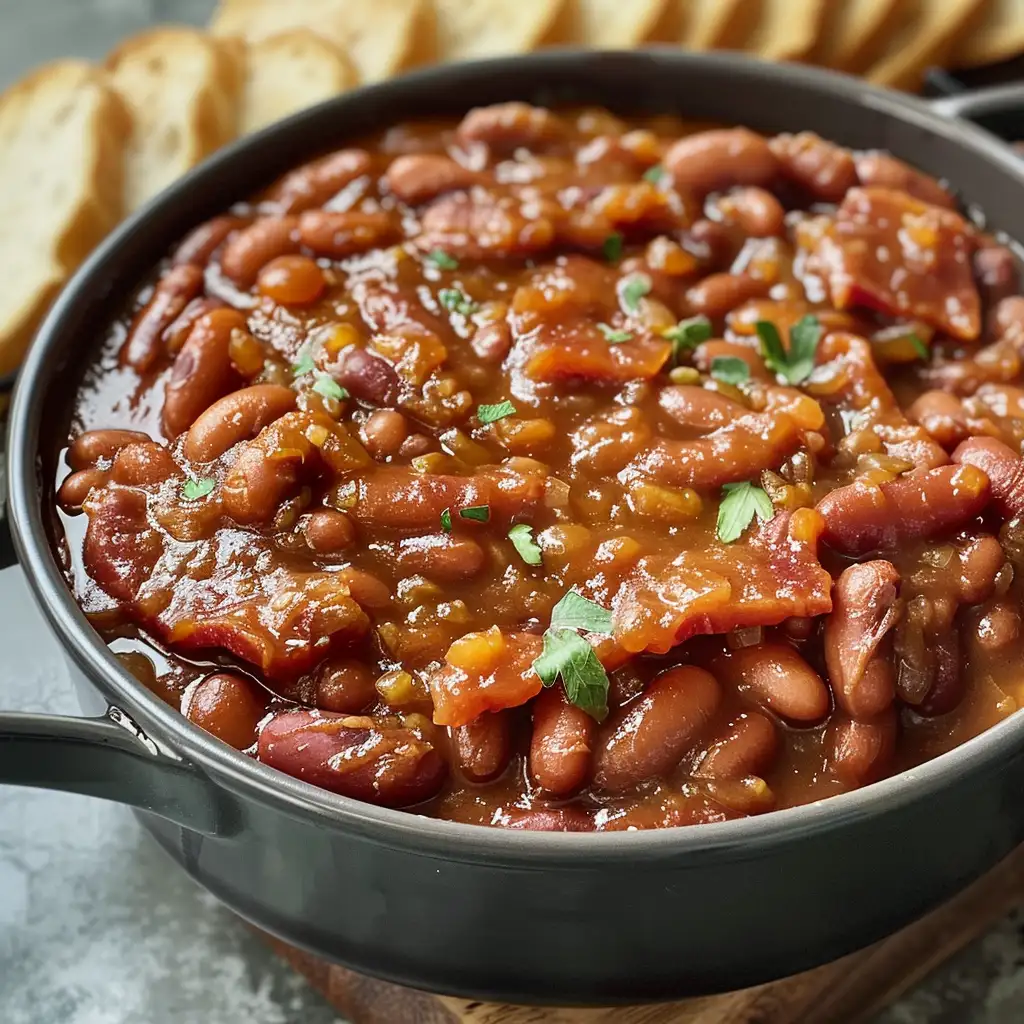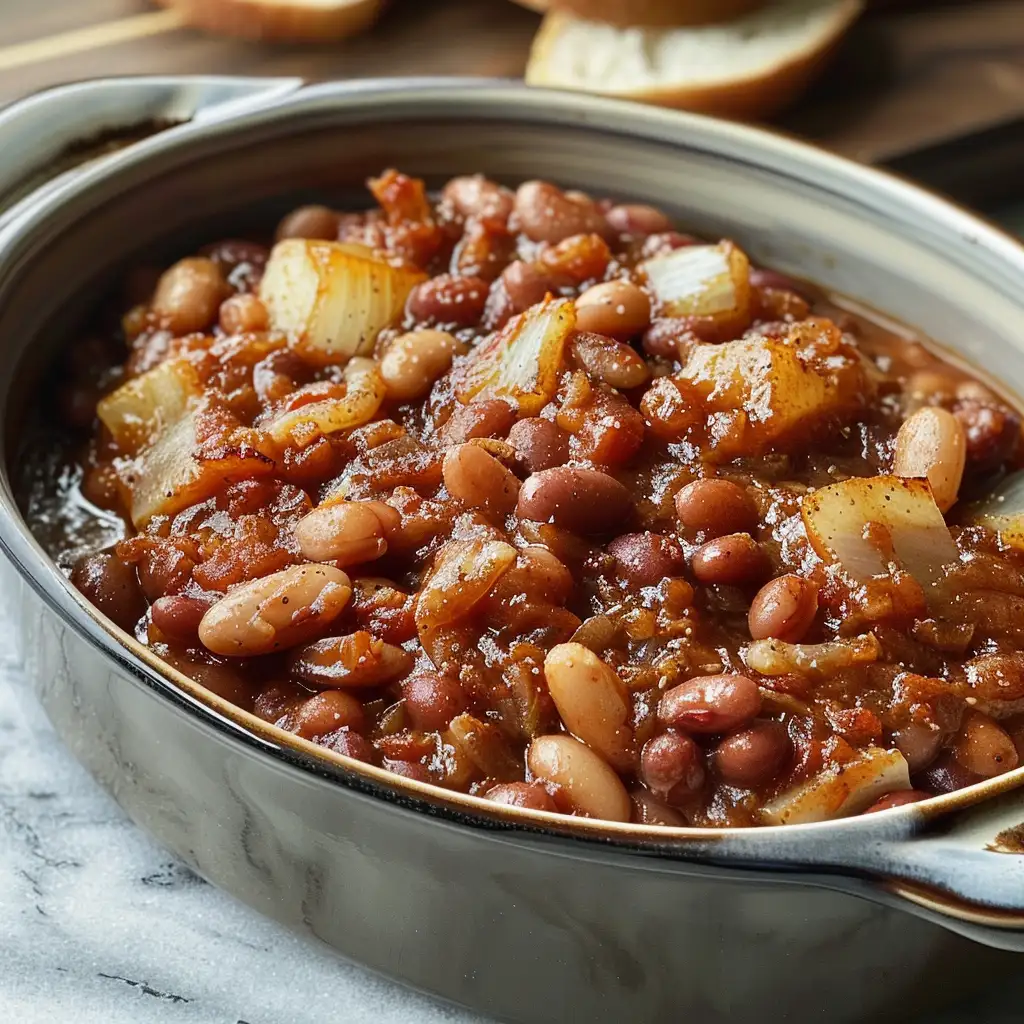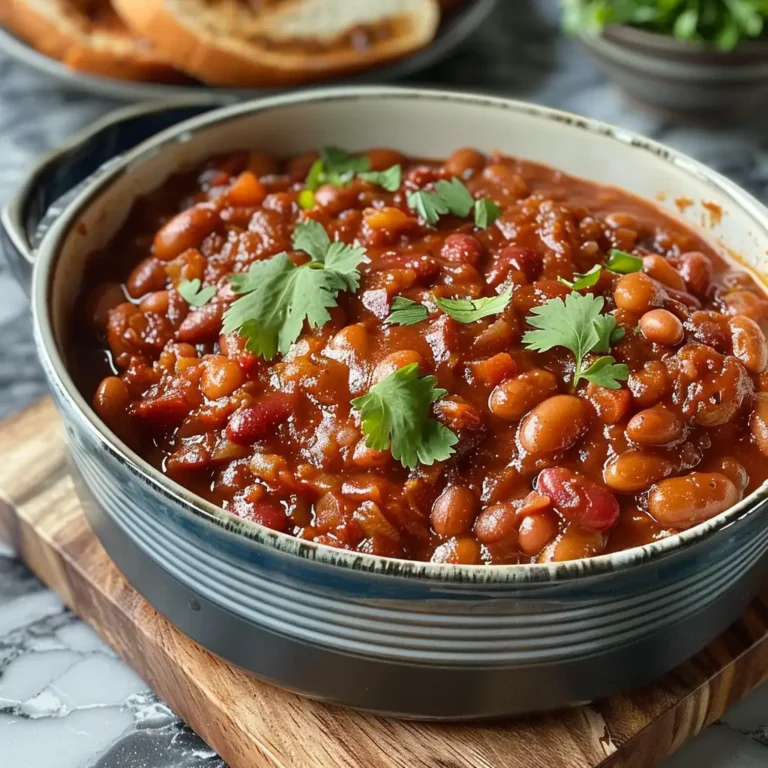Introduction to Baked Beans
Baked beans, a simple yet substantial dish, have roots that stretch far back into culinary history. Originally part of the Native American diet, they were adopted and adapted by European settlers, particularly in the United States and the United Kingdom. This dish typically consists of beans, slow-cooked in a sauce based primarily on tomato or molasses, often enriched with spices and, sometimes, pieces of pork or bacon.
- History and Origins: The historical journey of baked beans began with the Native Americans, who combined beans with maple syrup and bear fat, cooking them for hours. This method was then adapted by colonists, who introduced molasses and pork, ingredients more readily available at the time.
- Popularity and Cultural Significance: Today, baked beans are a staple across various cuisines. In the UK, they are often enjoyed as part of a full English breakfast, while in the US, they are a quintessential side dish at barbecues and picnics. Each culture has tweaked the recipe to fit local tastes and available ingredients, emphasizing the dish’s versatility and widespread appeal.
The ongoing debate between canned and homemade baked beans highlights a split in preference for convenience versus quality. Canned beans are prized for their convenience and consistency, offering a quick, ready-to-eat option that many find indispensable in fast-paced lifestyles. On the other hand, homemade baked beans allow for customization in flavor and potentially healthier choices by controlling ingredients like sugar and sodium.
- Overview of Canned vs. Homemade: Canned baked beans are typically pre-cooked and only require reheating, making them a convenient option for those short on time. Meanwhile, homemade baked beans afford the chef control over the types and amounts of sweeteners and fats used, often resulting in a dish that can be tailored to specific dietary needs and preferences. Those who prefer homemade beans also tend to value the traditional slow-cooking process, which can enhance the depth of flavor in the beans.
By understanding the origins, cultural significance, and variations in preparation, one can appreciate baked beans not only as a food but also as a cultural artifact that has adapted and endured through centuries.

Reviewing Popular Canned Baked Beans Brands
The world of canned baked beans is varied, with numerous brands offering their unique takes on this classic comfort food. Each brand brings something different to the table, from organic options to vegetarian delights, providing a range of flavors and textures to suit different palates and dietary preferences.
365 Everyday Value Organic Baked Beans
- Features: This product from Whole Foods Market’s private label is organic, making it a preferable choice for those looking to maintain an organic diet.
- Consumer Opinions: Many consumers appreciate the balanced sweetness and the firm texture of the beans, which hold up well during cooking.
Amy’s Organic Vegetarian Beans
- Distinct Features: Amy’s beans are known for their health-conscious ingredients and lack of meat products, catering to vegetarian and vegan diets.
- Reviews: The taste is often described as robust, with a good blend of spices that doesn’t overpower the natural bean flavor.
For a deeper dive into the nuances of crafting homemade baked beans, the Pioneer Woman’s best baked beans recipe offers insights and inspiration, highlighting the joys of making your beans from scratch, where every aspect of flavor can be tailored to personal taste.
B&M Original and Vegetarian Baked Beans
- Comparison and Taste Notes: B&M, a long-standing name in the baked beans market, provides both Original and Vegetarian options. The original version includes a touch of pork for added depth, whereas the vegetarian version focuses on a molasses-based sauce.
- Consumer Feedback: The original is often noted for its traditional flavor, while the vegetarian option is praised for its rich, almost smoky sweetness without the meat.
Bush’s Best Original and Vegetarian Baked Beans
- Why They Are Top-Rated: Bush’s Best beans are popular due to their consistent quality and flavorful sauce. The original version contains pieces of bacon and a hint of extra sweetness, making it a hit at family cookouts.
- Consumer Reviews: Both versions receive high marks for their creamy texture and well-balanced seasoning, with the vegetarian beans offering a comparable taste without the meat.
Campbell’s Pork & Beans
- Features: Known for their tomato-based sauce, Campbell’s Pork & Beans offer a slightly different take on traditional baked beans.
- Consumer Feedback: Reviews often mention the good balance of sweetness and tanginess, with a noticeable pork flavor that isn’t overwhelming.
For those interested in exploring different baked beans recipes and how they can be incorporated into various dishes, How Sweet Eats provides a detailed recipe that enhances the traditional baked beans with a unique blend of flavors.
Eden Organic Baked Beans—Sweet Sorghum
- Unique Attributes: These beans are distinguished by their use of sweet sorghum instead of the more common sugar or molasses. This choice impacts both the flavor profile and the nutritional content.
- Less Favorable Reviews: Some consumers find the texture too mushy and the flavor not in line with traditional baked beans, which can be a drawback for those expecting a classic taste.
Heinz Original Baked Beans
- Distinctive Taste: Heinz beans are a staple in many households, particularly in the UK, known for their tomato-rich sauce and smooth, soft beans.
- Consumer Opinions: Loyal consumers enjoy the consistency and comforting taste, although some find the beans a bit too simple or bland compared to more robust American styles.
Trader Joe’s Baked Beans
- Sweetness and Texture Evaluations: These baked beans are noted for their sweetness, which comes from a carefully crafted sauce that appeals to those who prefer a sweeter side dish.
- Consumer Opinions: The texture is generally well-received, with beans that maintain their integrity without becoming too mushy.
This comprehensive review of popular canned baked beans brands illustrates the variety available on the market, offering choices for every taste and dietary preference. Whether you prefer the deep, rich flavors of traditional beans with pork or the lighter, vegetarian-friendly versions, there’s a canned bean out there to satisfy your cravings.

How to Make Your Own Baked Beans
Creating your own baked beans at home allows for full control over the ingredients and flavors, making it a rewarding endeavor for any home cook.
Ingredients Needed for a Basic Recipe
- Beans: Typically navy beans or great northern beans, pre-soaked or pre-cooked
- Sauce Ingredients: Tomato sauce or ketchup, molasses or brown sugar, apple cider vinegar
- Flavorings: Mustard (dry or prepared), garlic powder, onion powder, salt, and pepper
- Optional Add-ins: Bacon, smoked pork, or maple syrup for different flavor profiles
Step-by-Step Guide to Preparing Baked Beans at Home
- Preparation: Begin by soaking your beans overnight if using dried, or use canned beans for a quicker start.
- Cook the beans: If using dried beans, simmer them in water until just tender, about 1 hour.
- Make the sauce: Combine the sauce ingredients and flavorings in a pot and bring to a simmer.
- Combine and bake: Mix the cooked beans and sauce together, transfer to a baking dish, and bake in a preheated oven at 325°F for 2-3 hours, stirring occasionally.
Tips for Customizing Flavor
- Experiment with Sweetness: Adjust the molasses or sugar levels depending on how sweet you like your beans.
- Spice It Up: Add chili powder or cayenne for a kick, or liquid smoke for a deeper, smoky flavor.
- Herbs and Spices: Consider thyme, rosemary, or bay leaves for aromatic depth.
For more insights on creating the perfect home-cooked baked beans, check out this detailed guide and recipe, which offers additional tips and variations.
Health Benefits and Nutritional Info
Baked beans are not only delicious but also offer various health benefits due to their high nutrient content.
Nutritional Breakdown of Baked Beans
- High in Protein and Fiber: Essential for muscle repair and digestive health.
- Rich in Vitamins and Minerals: Such as iron, magnesium, and potassium.
Health Benefits Associated with Regular Consumption
- Improved Digestive Health: Fiber content helps prevent constipation and promote gut health.
- Energy Boost: Complex carbohydrates in beans provide sustained energy.
Considerations for Dietary Restrictions
- Sugar and Sodium Content: Homemade versions can adjust these to suit dietary needs, crucial for those managing diabetes or hypertension.
Serving Suggestions and Pairings
Baked beans are versatile and can complement a variety of dishes:
- With Breakfast: Serve alongside eggs and toast for a hearty start.
- As a Side: Perfect with barbecue meats or vegetarian burgers.
- In Creative Dishes: Use as a filling for burritos or topping for baked potatoes.

FAQs
What makes a good canned baked bean?
- Flavor Balance: A good blend of sweetness, tanginess, and depth.
- Bean Quality: Tender yet intact, without mushiness.
How to enhance the flavor of bland baked beans?
- Add Extras: Incorporate more spices, a splash of vinegar, or extra sweetener to adjust the taste.
Are baked beans healthy?
- Nutrient-Rich: Yes, they provide protein, fiber, and other nutrients, though commercial varieties may be high in added sugars and salts.
For further information on enhancing your health with baked beans, consider consulting nutrition-focused resources that explore the benefits of incorporating beans into your diet. This comprehensive approach not only enhances the taste of your dishes but also contributes to a healthier lifestyle.

